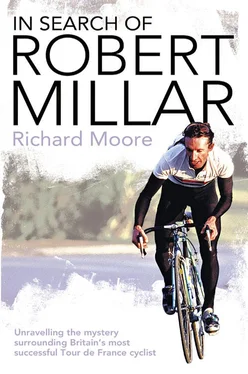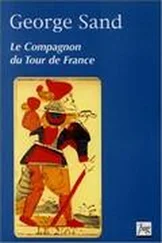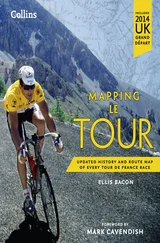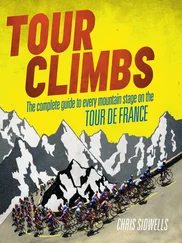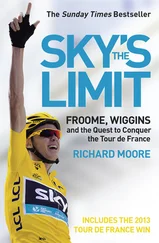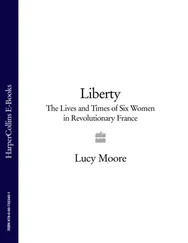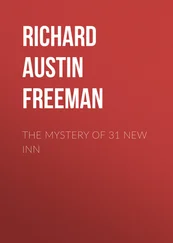The Glenmarnock club, which had been established in 1941, owed its popularity, especially among those just starting out in the sport, to John Storrie. Storrie had just turned 50 when he first encountered the 15-year-old Millar, but the small, skinny boy was one of many who received their first cycling lessons under Storrie’s tuition. Though the three boys came to the club via Jim Paton’s recommendation, Storrie favoured a direct approach to recruitment. While out cycling he would approach youngsters on their bikes, ask them if they enjoyed their cycling and whether they might be interested in joining a club. Then he would give them his business card. It is unlikely that such methods would be successful now, or even acceptable. As Storrie himself says: ‘That probably wouldn’t be allowed nowadays. Someone would complain. But I just wanted to introduce them to the bike.’
Most of the boys who joined the Glenmarnock, like Millar, Gibb and Brodie, wanted to race, and were impatient to do so. But for Storrie the club scene, and the ritual of the weekly club run, was just as important. It provided an informal education. It was where youngsters could learn how to cycle in a group, riding two abreast and sticking as close as possible to the back wheel of the rider in front in order to gain shelter and conserve energy for when it was their turn to take the pace at the front. When they stepped up to road racing, in large bunches of cyclists, the experience of training in a group would stand them in good stead.
The club runs were largely ordered, organized outings governed by an informal code of etiquette. To many newcomers to the sport the first club run can be quite intimidating, the experience of riding in such close proximity to other cyclists a nerve-shredding ordeal. And there had not so far been any obvious signs that Millar was blessed with a gift for cycling. Of the three friends, it was Tom Brodie who appeared to be the strongest, perhaps on account of his being a little older, and physically much bigger than the other two. Yet when all three joined the Glenmarnock Wheelers it became clear that it wasn’t just Brodie who had talent. Millar, his speed and bike-handling skills perhaps honed by chasing the rear bumpers of buses up and down the Ayr road, appeared to take to the club runs like a duck to water. ‘We quickly realized that we were as strong and fast as a lot of the guys who were racing quite regularly,’ said Gibb. ‘That came as a surprise to us.’
Gibb states that Millar, at this time, displayed none of the aloofness or the reluctance to engage with people that he showed later – at least not with him or Brodie. ‘It was a different kind of relationship he had with us than with most people. I’m not saying it was better or worse, but I think he was more relaxed in our company because we did so much cycling together. We did other things – going to the park, climbing into people’s gardens, stealing apples, all those kinds of things – but we just really enjoyed riding around on our bikes.’
Ten years after Millar’s induction to cycling, when he had already started to shine in the Tour de France, John Storrie wrote to Cycling magazine recalling his first impressions of Millar. ‘He was not a hooligan,’ he said, ‘but the best way to describe him at that age was that he was the “James Dean of cycling” – a bit of a rebel, but with one cause in mind: cycling. Like James Dean, he had a dislike for authority, probably stemming from his school days. He was not happy at work [Millar started an engineering apprenticeship after leaving school] but he could not take his mind off cycling. Cycling was in his thoughts night and day.’ Even so, when Jimmy Dorward came to give a lecture to the club, Storrie noted that ‘it was typical of Robert’s make-up that when it came to the technical part he became bored and had to be told off for reading Cycling in the middle of the lecture’. Storrie concluded his article by stating that the youngster was ‘quite a loner and conversation was confined to a few words’.
Storrie, now in his early eighties, suffered a stroke in 2002. While he struggles to recall some recent events his memories of the young Millar remain vivid. In particular he remembers some of the quirks of his personality. ‘When he first appeared he was a raw boy, a rough boy,’ he says. ‘He had shoulder-length hair, which no one else had at the time. He liked to be different. He was very quiet. He didn’t make friends easily. On the club runs we would have drum-ups by the side of Loch Lomond, so we’d all stop and make a fire and sit down together. But Robert would go away on his own, maybe fifty yards away, and light his own fire. He did that every time. I didn’t try to bring him into the group. I just let him get on with it. We joked about him wanting to be on his own but he never gave us an explanation. I don’t remember him not liking people; he was just a loner.’
Jimmy Dorward, who was running the Scotia club at the time and encountered Millar on occasional club runs, recalls a similar incident. ‘We stopped for the drum-up and the young lads arrived with Robert Millar,’ he explains. ‘We got the fire going, and after a while I realized Millar wasn’t there. “Where’s Millar?” I asked. “Oh, he’s away,” someone said. That was unheard of. If you went to a club’s drum-up you collected a few sticks and when you left you said, “Thanks for the drum.” But that was Millar’s nature. He just drifted off.’
Another strange episode that Storrie remembers was a club run that ended with a stop on a private beach by the banks of the Lake of Menteith, around twenty miles north of Glasgow. It was a glorious summer’s day and Storrie, having obtained the permission of the house owner, allowed his young charges to go swimming. The condition stipulated by the land owner was that they behaved themselves, and all complied, except one: the rebel. While everyone else stripped off and went swimming, Millar kept his racing clothing on and stepped into the water until it was up to his knees. ‘He was a devil,’ says Storrie, smiling now. ‘He collected a pile of stones, holding them in his jersey, and he started throwing them at the boats. He kept throwing stones into one boat; he had so many stones in his jersey that I thought he was going to sink it. I kept saying “Robert, stop that!” but he just laughed. I couldn’t get a word out of him. Eventually I paddled out to where he was and tipped him into the water. He wasn’t happy. He came out the water shouting, “They were my fucking good cycling shorts!” They were soaking wet.’
Storrie declares himself unsure whether Millar might have got into more serious trouble had cycling not provided an outlet for his energy, allowing him to channel his rebellious streak. But he does point out that Millar would not be unique had he been ‘saved’ by cycling. ‘That was the good thing about what I was doing. I was taking people away on the bike, getting them out of Glasgow, away from trouble. It was the ambition of a lot of kids to own a bike and I let them come along whatever bike they had. Some clubs would have said, “Away you go, that’s not suitable.” But if someone came out with us, as long as they could pedal, I’d let them come. I made allowances. I waited for them at the top of a hill. Others didn’t.’
The other thing Storrie remembers is Millar’s burgeoning ability as a cyclist, in particular his apparent fondness for hills. ‘When you hit a hill he loved to jump away and get up it first. He was competitive. He was naturally strong, really outstanding.’
Though he could be difficult, Storrie retains fond memories of the teenaged Millar, and even fonder ones of watching his career blossom on the biggest stage of all, the Tour de France. As he wrote in Cycling in 1984, ‘What a great thrill it was to see Robert on TV in 1983, winning the Pyrenean stage, then winning the same stage in 1984 against heavy odds … I am not ashamed to say that I shed tears of emotion as he danced away to victory, and even now, on the video re-run, I still get glassy-eyed. Knowing Millar, I can safely say, quoting Al Jolson, “We ain’t seen nothin’ yet.”’
Читать дальше
